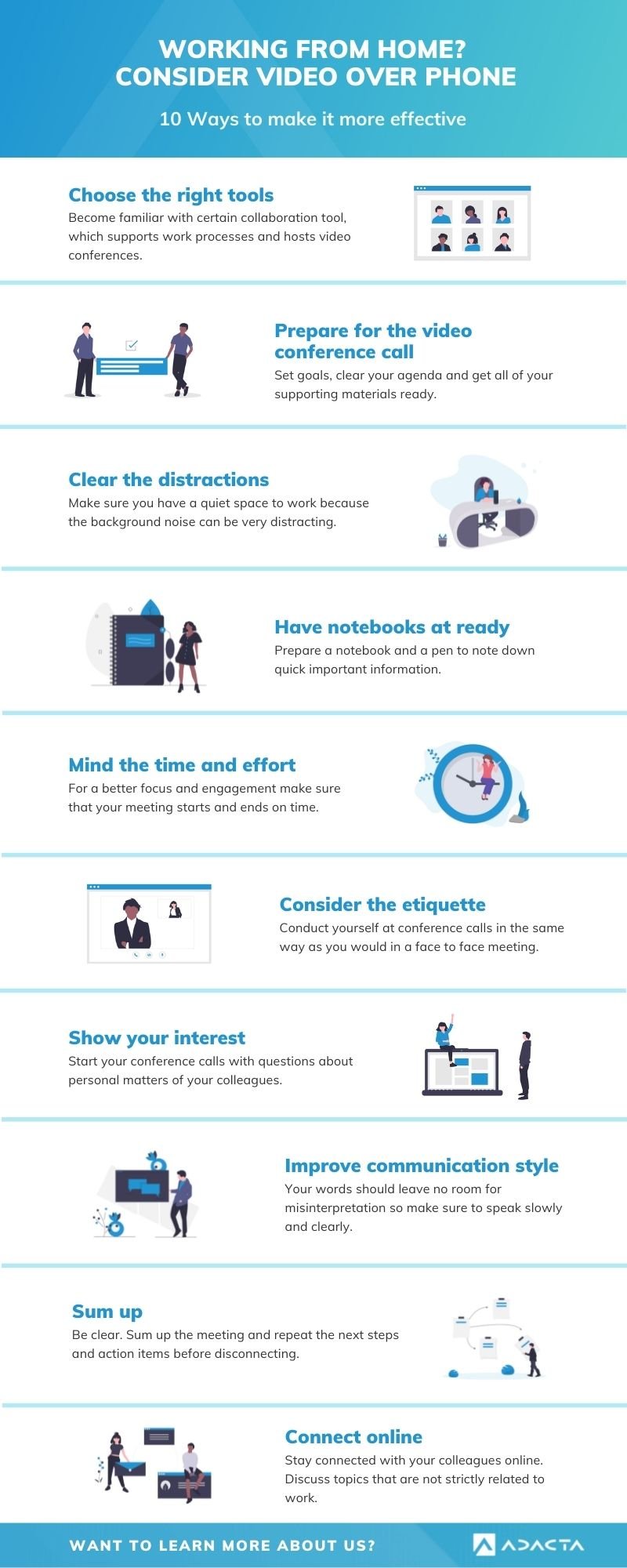
Working from home? Consider video over phone
Technology is helping remote workers build better relationships. For a double effect, switch on the video.
We have worked from home for more than a week. Apart from our location not much has changed. You see, most of us at Adacta already work in remote teams. Under normal circumstances, some teams are based in anywhere from 3 to 6 different locations. The number is higher in teams working on projects. Since we have switched to home offices, the number of locations from which people are joining conferences grew to 200 and we noticed more than 100 concurrent connections to our IT environment. Our modus operandi, however, is the same. Each morning, our teams and our clients’ teams meet at the same time for their daily, 15-minute conference call focused on updates, addressing concerns and plans for the day. The difference? We are switching to video conferencing.
Why? Because remote work does not equal home office. Home office means there are no discussions over hot coffee in our kitchenette. No snacking on fresh fruit. No lively semi-work-related discussions that spark creativity.
These limitations are hardly comparable to the issues other industries and companies are facing but are worth addressing if we want to maintain productivity, creativity and team spirit we had before we started working from home. In situations like this, seeing familiar faces becomes more important than ever.
But first, let’s talk technology and operations. Video conference calls require a little more preparation than face-to-face meetings. Here are some notes from our colleagues.Choose the right tools
“Our teams have been working remotely long before we have moved to home offices and we are familiar with the Microsoft Teams collaboration tool. Despite the increased number of users over the past few weeks, Teams has proved to be a very reliable tool (despite some interuruptions) that supports our work processes and hosts video conferences.” Gašper Mozetič, CIO, CISO.
Prepare for the video conference call
Whether you have an internal or external video conference call, prepare: set goals, clear your agenda and get all of your supporting materials ready. By scheduling in advance, you make sure people have the time to join the meeting. It is also worth checking when people are taking breaks as well as starting and ending their workdays. This way you avoid unnecessary rescheduling.
Clear the distractions
Make sure you have a quiet space to work in – no family or pets allowed. Not only is the background noise very distracting for our thoughts, it also affects everyone on the conference call while keeping the focus away from the point you are trying to make.
Have notebooks at ready
“Each conference call is followed by sharing meeting minutes with other participants. Despite that, it might be worth noting down the important information, especially that which is related to your work. If you are leading the meeting, make sure you ask your colleagues to write down the meeting minutes. This will let you focus on the agenda and the goal. Some teams are recording their video conference calls but only with the agreement of everyone involved.” Neva Port, Quality Assurance Project Manager.
Mind the time and effort
Don’t assume people have nothing to do because they are working from home. Make sure your meeting starts and ends on time. Invite only the people who should be included. This will ensure your conference calls stay focused and participants engaged.
Second, the rules of engagement.
Consider the etiquette
You should conduct yourself at conference calls in the same way as you would in a face to face meeting. The same rules apply: be prepared, dress appropriately, and don't interrupt.
Show your interest
There are usually a few minutes at the beginning of the conference call when everyone is joining in. Use this time to ask your colleagues about personal matters – how they are doing, what are they reading or similar. Follow up on their answer at the next meeting. Meetings with clients are a bit different, of course, although over time they end up seeing us as a part of their team. That is when we can start our conference calls on a more personal note.
Improve communication style
According to research, how you say it is just as important as what you say. Make sure your words leave no room for misinterpretation and make sure to speak slowly and clearly. Turning on video enables others to read your facial expressions and puts your words in context. This way, you can avoid the “Oh, I didn’t mean it like that” situations.
Sum up
When many people join a conference call, it is important to be clear. Make sure to sum up the meeting and repeat the next steps and action items before disconnecting.
Connect online
“Starting next week, everyone at Adacta Fintech Brno will get together on Teams for a small talk, coffee and snacks. The idea is we stay connected and discuss things and topics that are not strictly related to work or part of our daily status calls.” Benjamin Levstek, Country Manager Czech Republic.





